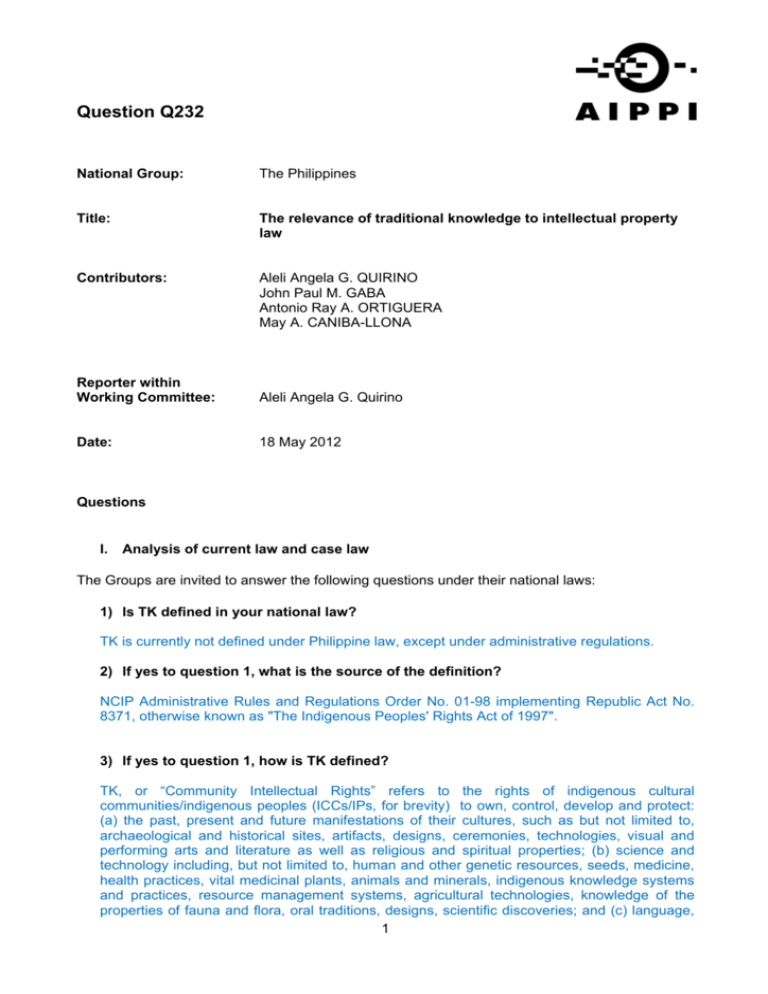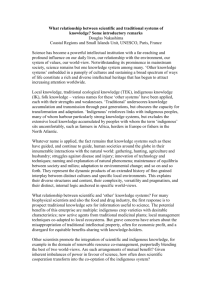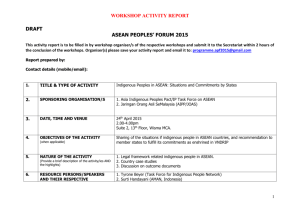Philippines
advertisement

Question Q232 National Group: The Philippines Title: The relevance of traditional knowledge to intellectual property law Contributors: Aleli Angela G. QUIRINO John Paul M. GABA Antonio Ray A. ORTIGUERA May A. CANIBA-LLONA Reporter within Working Committee: Aleli Angela G. Quirino Date: 18 May 2012 Questions I. Analysis of current law and case law The Groups are invited to answer the following questions under their national laws: 1) Is TK defined in your national law? TK is currently not defined under Philippine law, except under administrative regulations. 2) If yes to question 1, what is the source of the definition? NCIP Administrative Rules and Regulations Order No. 01-98 implementing Republic Act No. 8371, otherwise known as "The Indigenous Peoples' Rights Act of 1997". 3) If yes to question 1, how is TK defined? TK, or “Community Intellectual Rights” refers to the rights of indigenous cultural communities/indigenous peoples (ICCs/IPs, for brevity) to own, control, develop and protect: (a) the past, present and future manifestations of their cultures, such as but not limited to, archaeological and historical sites, artifacts, designs, ceremonies, technologies, visual and performing arts and literature as well as religious and spiritual properties; (b) science and technology including, but not limited to, human and other genetic resources, seeds, medicine, health practices, vital medicinal plants, animals and minerals, indigenous knowledge systems and practices, resource management systems, agricultural technologies, knowledge of the properties of fauna and flora, oral traditions, designs, scientific discoveries; and (c) language, 1 script, histories, oral traditions and teaching and learning systems (Rule II, Section 1, NCIP Administrative Rules and Regulations Order No. 01-98). 4) If TK is not defined in your national law, is there any 'working definition' described in any draft law or regulation, policy document or other discussion material? N/A. 5) Does your national law provide for any protection (whether positive or defensive) for TK? Yes. 6) If yes to question 5, is the protection found in: a) b) c) existing IP laws or regulations; adaptation of IP laws or regulations through sui generis measures for TK protection; or wholly sui generis laws or regulations relating to TK protection? Yes, through the adaptation of intellectual property laws or regulations by way of sui generis measures to protect TK, and sui generis laws and regulations relating to TK protection. 7) If yes, to any part of question 6, please provide details of the law(s) or regulation(s), including where such detail exists: A. Traditional and Alternative Medicine Act (Republic Act No. 8423) This statute created the Philippine Institute of Traditional and Alternative Health Care (PITAHC, for brevity) for the purpose of accelerating the development of traditional and alternative health care in the Philippines. PITAHC was mandated, among others, to develop workable mechanisms, in accordance with the customary practices of the place, for the identification and documentation of indigenous knowledge systems relevant to the utilization of biological and genetic resources that are applied in traditional and alternative health care practices of the community. B. Indigenous Peoples‘ Rights Act (Republic Act No. 8371) Under this statute, indigenous cultural communities/indigenous peoples were recognized to have the right to full ownership and control and protection of their cultural and intellectual rights; to have the right to special measures to control, develop and protect their sciences, technologies and cultural manifestations, including human and other genetic resources, seeds, including derivatives of these resources, traditional medicines and health practices, vital medicinal plants, animals and minerals, indigenous knowledge systems and practices, knowledge of the properties of fauna and flora, oral traditions, literature, designs, and visual and performing arts. 8) Are the protections described in response to questions 6 and 7 – a) b) referable to TK alone; or related to or linked to the concepts of protection of: (i) genetic resources; or (ii) TCEs? 2 The protections described above are related or linked to the concepts of protection of genetic resources and TCEs. If yes to question 8(b), please provide details of any linkages. –. The Traditional and Alternative Medicines Act covers all biological and genetic resources that are applied in traditional and alternative health care practices as well as indigenuous knowledge systems. Indigenous Peoples’ Rights Acts seeks to preserve the communities/indigenous peoples culture, traditions, and institutions. indigenous cultural 9) Please identify any shortcomings in any protection of TK in your country by reference to the matters in questions 6 to 9 above. The laws discussed above do not provide adequate protection for TK. They do not sufficiently specify the rights and remedies, as well as the procedure and mechanisms, in order to protect the indigenous cultural communities/indigenous peoples’ TK. 11) Please identify any significant case law in connection with protection of TK in your country. None. II. Proposals for harmonisation The Groups are invited to put forward proposals for the adoption of harmonised rules in relation to the role of TK in relation to IP law. 12) Is a harmonised definition of TK desirable? Yes, provided that the vast cultural differences among countries will be taken into account. The harmonized definition should recognize that each indigenous community is unique and distinct. For this reason, the definition should allow each of the countries enough flexibility to promulgate national legislations aimed to fully and sufficiently encompass the nature and essence of all the TK originating from their respective countries, indigenous peoples/groups or local cultural community. 13) If yes to question 12, please propose a definition of TK, or the concepts that should be included in any proposed harmonised definition of TK. Consistent with our answer to Item No. 12, we find that the definition of TK by the Draft Articles of WIPO on “The Protection of Traditional Knowledge”, which provides that traditional knowledge refers to the know-how, skills, innovations, practices, and learning resulting from intellectual activity in a traditional context, provides the most flexibility to countries. 14) Is it desirable to have only one form of protection for TK, either positive or defensive, or both forms? Please state reasons. It is desirable to have several positive and defensive forms of protection for TK. Since TK may comprise the knowledge systems of indigenous or local communities, covering intellectual capital, cultural identity, spiritual beliefs and customary legal systems, one form of protection 3 may not be adequate. To be effective, the form of protection should consider the specific aspect of the TK and how it is protected from misuse and infringement. 15) Should TK be protected by: a) existing IP laws or regulations; b) adaptation of IP laws or regulations through sui generis measures for TK protection; or c) wholly sui generis laws or regulations relating to TK protection? In your answer, please identify which and state reasons. Adoption of sui generis laws or regulations relating to TK protection is desirable because of the peculiar character of TK vis-a-vis core intellectual property. TK refers to the wealth of knowledge already in existence, and considered unprotected and freely available to the public, which is sought to be protected or excluded from the public domain. Whereas, intellectual property refers to the creation of new knowledge or information that are not yet in the public domain and remains under the control and the exclusive right of the creator or inventor. Since the subject matter of protection under IP laws is inherently different from TK, it is better that TK be protected by wholly sui generis laws. 16) If yes to any part of question 15, is a harmonised approach to protection desirable? In your answer, please state reasons. Yes, a harmonised approach to protection is desirable provided that countries are given enough prerogative to determine the manner, form, and mechanism of protection for TK. Providing countries the flexibility to design their respective national legislations that are compatible with the peculiar nature of TK in every country is necessary in order for it to be an effective tool for the assertion of the indigenous peoples’ rights with respect to their resources and knowledge. 17) If yes to question 16, how should that approach be implemented: a) b) at an international level; and at a national or regional level? The approach should be initially implemented at the national or regional level for it to be an effective tool by which the indigenous peoples may assert their rights to their resources and knowledge. This does not preclude the promulgation of general principles at the international level which will serve as the parameters or minimum standards within which the TK rights at the national level may be enforced. 18) Having regard to WIPO/GRTKF/IC/19/5, please provide any proposals you have as to a harmonised approach concerning: Considering that vast cultural differences exist among countries, we propose to adopt the following provisions of the WIPO Draft Articles on “The Protection of Traditional Knowledge” which we believe take into account the promulgation of national laws and adoption of TK definitions embracing the most general terms: a) Definition of TK; Traditional knowledge refers to the know-how, skills, innovations, practices, and learning resulting from intellectual activity in a traditional context (Option 3). b) criteria for eligibility for protection; 4 Identified with [integral to] the cultural identity of a [local, indigenous or traditional peoples or communities or nations] that is recognized as the owner through a form of custodian or collective and cultural ownership responsibility. Such a relationship may be established formally or informally by customary practices, laws or protocols. [Alternative (c), Option 1] c) beneficiaries of protection; Beneficiaries of protection include indigenous peoples, local communities and nations, in accordance with national legislation. d) scope of protection; [Contracting parties] Member States shall [/should] provide adequate and effective legal means/measures to ensure the application of these rights taking into account relevant customary laws and practices. e) sanctions, remedies and exercise of rights; Member States shall [/should] ensure that enforcement procedures are available under their laws against the [willful or negligent] infringement of the protection provided to traditional knowledge under this instrument sufficient to constitute a deterrent to further infringements. (Option 1, 4.2) f) administration of rights; The establishment of a national or regional authority or authorities under this article is without prejudice to the national law and the right of traditional knowledge owners to administer their rights according to their customary protocols, understandings, laws and practices. In the case that the Member State decides thus that they should establish this authority: A Member State [contracting party] shall [may] free, prior and informed consent of [in consultation with] the owners [holders] of traditional knowledge in accordance with its national law, may establish or appoint an appropriate national or regional competent authority or authorities. The functions may include, but need not be limited to, the following: (a) disseminate [disseminating] information and promoting practices about traditional knowledge and its protection under protection of its beneficiaries; (b) ascertaining whether free, prior informed consent has been obtained; (5.1) g) exceptions to and limitations on rights; It shall be a matter of national law to permit [Parties may adopt] appropriate limitations or exceptions, provided such exceptions are limited and do not conflict with the normal use of the traditional knowledge by the beneficiaries and do not unreasonably prejudice the legitimate interests of the beneficiaries[,taking into account the legitimate interests of third parties] (Option 2, 6.2) h) term of protection; Protection of traditional knowledge shall [should] last as long as the traditional knowledge fulfils the criteria of eligibility for protection according to Article 1. (Option 1) 5 i) formalities to which protection is subject; The protection of traditional knowledge should [shall] not be subject to any formality. (Option 1, 8.1) j) transitional measures; The state should ensure the necessary measures to secure the rights [acknowledged by national [or] domestic law,] already acquired by third parties in accordance with its national law and its international legal obligations. (Option 1, 9.2) k) consistency with other laws; In accordance with Article 45 of the United Nations Declaration on the Rights of Indigenous Peoples, nothing in this instrument may be construed as diminishing or extinguishing the rights that indigenous peoples have now or may acquire in the future. (Alternative, 10.2) l) national treatment and foreign interests; and Reciprocity m) trans-boundary cooperation. In instances where traditional knowledge is located in territories of different States / Member States [contracting Parties], those States / Member States [contracting Parties] should [shall] cooperate by taking measures that are supportive of and do not run counter to the objectives of this instrument. This cooperation should [shall] be done with the participation [and consent] / [and prior informed consent] of the traditional knowledge owners [holders]. Summary Being an archipelagic state composed of more than 7,100 islands, the Philippines is a culturally diverse country. According to the latest study of United Nations Development Programme (2010), it is estimated that almost 17 million (or around 18%) of the country’s population are Indigenous Peoples, spread out to an estimated 110 ethno-linguistic groups. Realizing the importance of the Indigenous Peoples sector, several sui generis national legislations were enacted to address the peculiar needs and interests thereof. However, poverty and underdevelopment are widespread among localities where Indigenous Peoples communities are concentrated. Among others, the protection of traditional knowledge is considered as a tool for their economic empowerment. As the adaptation of common legal regimes appear to be ineffective, the formulation of laws, policies, and alternative measures that would effectively address the particular needs and requirements of Indigenous Peoples become imperative. 6 ANNEXURE A Resolution Question Q166 Intellectual Property and Genetic Resources, Traditional Knowledge and Folklore AIPPI Observing the struggle of the WIPO Intergovernmental Committee on Intellectual Property and Genetic Resources, Traditional Knowledge and Folklore to come to final conclusions on the topics; Noting that the Convention on Biological Diversity accepts the sovereignty of states over their genetic resources and traditional knowledge connected with it, and puts forward the concept of prior informed consent and access and benefit sharing when utilising such resources; many member countries of the Convention on Biological Diversity have not yet set up mechanisms how to access genetic resources under their control and how to get prior informed consent; Mindful that the patent system is intended to encourage inventors to disclose their inventions to the public in return for a monopoly period in which patent owners may prevent others from practising the invention, and that an invention is a solution to a technical problem; patents should only be granted for inventions which are new, not obvious and capable of industrial application, and should contain disclosure of the invention sufficient to enable the skilled person in the art to work the invention; the patent system cannot prevent unlawful use of genetic material or traditional know– ledge in research, development, marketing of products, or trade; Supporting that users of genetic material and traditional knowledge connected with it comply with the requirements of the Convention on Biological Diversity and national laws in this respect. Resolves: 1) Traditional knowledge in the public domain should be treated as other information in the public domain for the assessment of patentability of inventions. 2) The patent system is not suitable to control whether the requirements of the Convention on Biological Diversity are met, in particular since research results and products in commerce and trade need not be covered by patents. 3) If national laws require a declaration of the source of genetic material and traditional knowledge in patent applications, such laws should: – only require that the patent applicant to the best of his knowledge identifies the source from which the inventor obtained the genetic material or the information based on traditional knowledge; 7 – entitle the applicant to rectify any failure to indicate the source or add any later information obtained on the origin of the genetic material. 4) Ways and means other than patent applications should be developed to deal with prior informed consent and access and benefit sharing concerning genetic resources and traditional knowledge connected with it. 8









